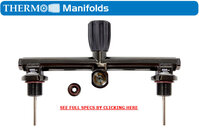Many years ago I had a set of double 40cf bottles, with only one open/shut valve, centrally located. They gave me a bit more air than my 72cf, but more importantly they were much better balanced.
I've tried to replace them, but every manufacturer seem to make these complex double isolation valves for technical diving when all I want is a double that does not provide additional air, just better weight distribution and balance on my back.
The only spg needed was, of course, attached to the regulator. My little bail out bottle had its own regulator and spg.
I really wish I could replace that old unit, perhaps updated with a din regulator mount, just one for both bottles, something simple and strong. It was really wonderful for recreational diving.
I've tried to replace them, but every manufacturer seem to make these complex double isolation valves for technical diving when all I want is a double that does not provide additional air, just better weight distribution and balance on my back.
The only spg needed was, of course, attached to the regulator. My little bail out bottle had its own regulator and spg.
I really wish I could replace that old unit, perhaps updated with a din regulator mount, just one for both bottles, something simple and strong. It was really wonderful for recreational diving.




